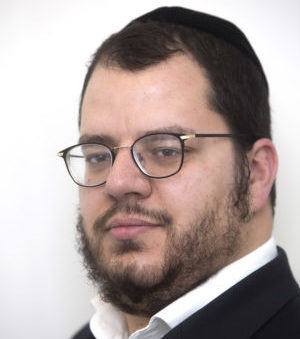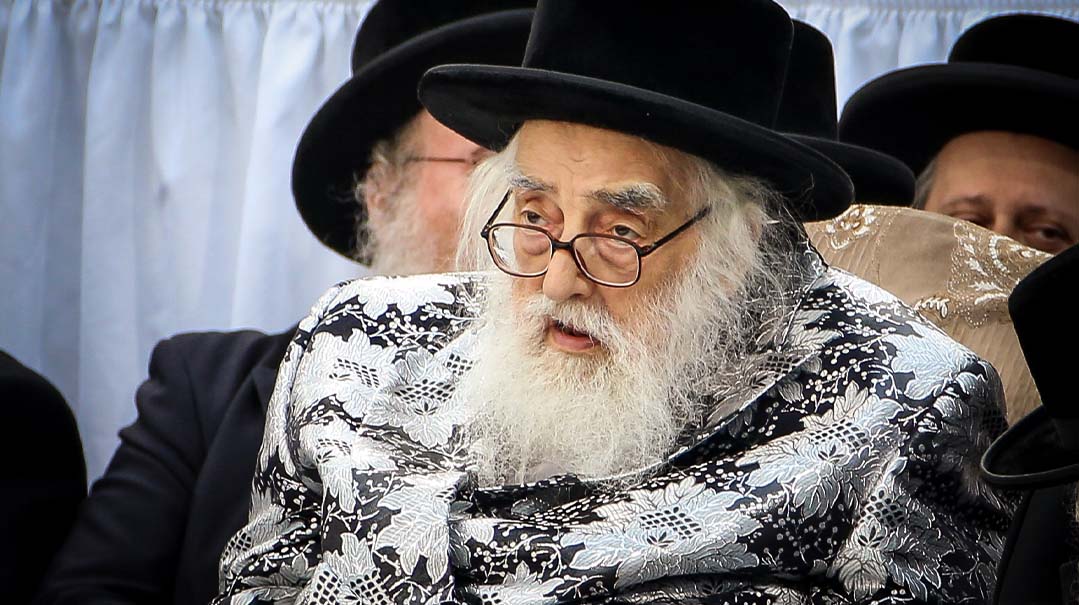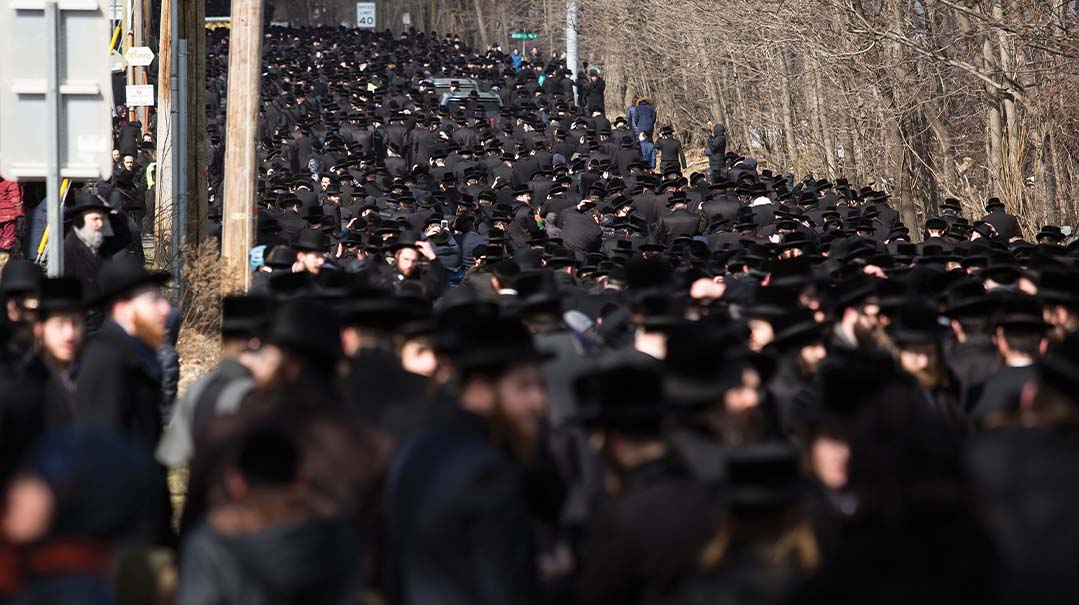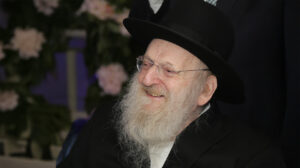A Singular Foundation


Rebbe Mordechai Hager of Vizhnitz-Monsey built his chassidus with the sheer force of his own exalted presence, uncompromising values, and personal example

Photos: Yossi Goldberger, Avraham Sorkis Archives, Amir Levy
W
hen you look at the sprawling Vizhnitzer beis medrash in Monsey, hub of a glorious kehillah, you’ll likely be impressed. It’s a chassidus with satellite communities all over the world — Brooklyn and Kiamesha, London, Montreal, and Eretz Yisrael — and it encompasses respected yeshivos and quality avreichim and families.
It’s even more remarkable for those who were privileged to know the Rebbe, Rav Mordechai Hager ztz”l, who was niftar on Erev Shabbos after a long illness. The Rebbe, a scion of the Vizhnitzer Rebbes of Europe, built this empire on American soil without the usual tools of leadership. You looked at the tzaddik of Monsey and you saw a saintly figure who was clearly bound up with Heaven, immersed in his own thoughts. He wasn’t a rebbe who offered motivational derashos and an acute understanding of business. The rebbe built up a chassidus with the sheer force of his own exalted presence and uncompromising values. Like an experienced contractor, he built by knowing what he expected, what he wanted, and how to achieve it.
He started with so little, Monsey old-timers remember. When he emerged from the ashes and began building a chassidus in America, all he had was a handful of survivors who’d lost their yeshivah years while trying to survive, now overwhelmed with the demands of trying to make a living and getting by in this new world of the United States. The Rebbe made it clear, early on, that there’s only one way to build: Torah.
“Don’t bring me kvittlach,” the Monsey-Vizhnitz Rebbe cried. “Bring me sha’os tzetlach,” the papers upon which the Rebbe expected every chassid to write how much they were learning each week, and with whom.
He built a chassidus not by saying, but by doing. The strongest imperative and most enduring lesson to his chassidim was his personal example. The children and grandchildren of those first chassidim understood that a chassid has an open Gemara before him at all times.
The Rebbe was famous for his tremendous diligence in learning. Between petitioners, he would snatch any available moment to learn a few more lines of Gemara, another mishnah. He was mesader kiddushin for every chasunah in his court — the chuppahs took place just outside his home — but only between chavrusos. There was a 20-minute window in which he would come out, officiate, bless the new couple, and then return to his room and his seforim.
This past Elul, a follower of a different chassidus brought his son to the Rebbe for a brachah. After he was escorted in to the Rebbe, he put down a wad of money and said, “Rebbe, I have 18,000 dollars here.” The Rebbe did not react.
Then the man said, “And this is my son, who just completed Shishah Sidrei Mishnah.” The Rebbe’s face lit up and he embraced the bochur. Those Mishnayos, the spiritual achievements, were the currency of his heart.
Seder in the Bunker
The Rebbe wasn’t just a compassionate mother to his chassidim, but also a firm father. Until he was too weak, the Rebbe himself would conduct surprise inspections at the shtiblach of the chassidus. He would go down after Shacharis to see who was davening where, to make sure that no minyan would miss zeman tefillah, to observe the pace and decorum of each minyan.
The glistening black eyes saw something that no one else could: He’d seen what Vizhnitz could be, and he aimed to recapture that goal.
Rebbe Mordechai Hager was born on the 18th of Tammuz 5682 (1922) in Grossvardein, the cradle of activity of Vizhnitz chassidus between the two world wars. Grossvardein (part of Hungary then, now known as Oradea and part of Romania) was the home of the Ahavas Yisrael, Rav Yisrael Hager, and his son, the Imrei Chaim, Rav Chaim Meir. The Rebbe’s brother, the Yeshuos Moshe, was six years older than he, and as there weren’t many grandchildren around then, the Rebbe was able to form a very close relationship with his grandfather, the Ahavas Yisrael. The Ahavas Yisrael was niftar around the time of the Rebbe’s bar mitzvah, but they’d spent enough time together for the Rebbe to remain bound to his grandfather for the rest of his life.
In his youth, the Rebbe learned in Szekelyhid (S?cueni) near Grossvardein; in the yeshivah of Rebbe Yoel of Satmar in Romania; and in Pupa, under the Vayechi Yosef. But most of his teenage years were spent learning on his own in the court of his father, the Imrei Chaim.
The Rebbe was 18 years old when the Second World War broke out. The region remained untouched for the first four years of the war. While the Monsey-Vizhnitz Rebbe was very wary of publicity and never allowed his photo to be taken, he conducted a rare conversation several years ago with Mishpacha’s Aryeh Ehrlich, in which he detailed the miracles of his escape from the Nazis. His gratitude was still fresh, decades later, and his remarkable memory included the smallest details of the fraught odyssey.
“We in Hungary had no idea what was happening to the Jews in Poland,” he said. “We were completely cut off from them, and we hadn’t heard anything about the murders and the suffering of our fellow Jews there. It was only in the middle of 5703 (1943) that one of the first refugees from Poland came. His name was Reb Mendel Feiger, a Kossover chassid, and he told us what was happening. Many Polish refugees came after him, who told us even more horrific stories of the brutal slaughtering of Jews. The Belzer Rebbe, and relatives of Dzhikov, Riminov, and Bobov and others were among the refugees, and when we heard what they had to say, we felt faint.”
On the 24th day of Adar 5704 (1944), the Germans captured Hungary. Hungary’s turn seemed to have come. It was all too clear that the Vizhnitzer Rebbe and his children had to escape. The most feasible destination seemed to be Romania, just over the border and not under Nazi control. But Pesach was coming, and while they planned their escape, they also prepared for Pesach in hiding.
Rebbe Mordechai remembered the Seder that his father, the Imrei Chaim, conducted on Pesach of 1944, in the bunker they’d just finished digging. It was customary for the chassidim to celebrate with the Imrei Chaim, but that year, no one was allowed to join the Rebbe except for his sons, Moshe Yehoshua and Mordechai, his son-in-law Rebbe Yudeleh Horowitz, his nephew, Yehoshua Hager-Lau, and his daughters — among them Tzipora Friedman (Ben Shalom) who escaped on the last day of Pesach.
After Yom Tov, the future Rebbe of Monsey-Vizhnitz prepared to leave by making one last visit to the kever of his grandfather, the Ahavas Yisrael. When they left the ohel, a group of Germans saw them and approached.
And the Rebbe himself would recall, in later years, “I decided not to run away because, as it is brought in the Zohar Hakadosh regarding Yaakov and Eisav, if you stand up to the goyim they have no control over you. And in fact, they didn’t do anything to me. They insulted me a bit but they didn’t touch me.”
Not Even for a Second
Then the journey to Romania began. Later, the Rebbe would recall how, “Di gantze veg hot men nisht oifgehert tzu zaggen mittin moil devarim b’kedushah. Men hot nisht mesiach daas geven kain rega (We didn’t stop saying divrei kedushah the entire way. We didn’t take our minds off of it for even a moment.)”
The bochur carried a single bag containing his tefillin, a Chumash, some food and clothing, and a cream to remove his beard and peyos if necessary. He also took a volume with three seforim bound as one — Tanya, Yesod V’Shoresh Ha’avodah, and Likutei Torah of Rebbe Mordechai of Chernobyl zy”a, for whom he was named.
(Decades later, gabbaim noticed that the old sefer was starting to crumble, but the Rebbe refused to allow them to replace it with newer editions of the three classic seforim. He wanted it rebound, despite the fact that it was a costly process and the Rebbe lived frugally. The Rebbe explained that he’d learned from the sefer in a time of great hardship and it had special meaning to him.)
“I did not take my mind off my emunah in Hashem Yisbarach and from limud haTorah for even a second,” he recounted. “I focused on the pasuk in Devarim 5:26: Mi yiten v’haya levavam zeh l’yiras osi kol hayamim — Would that their hearts be like this, to fear Me and to keep all My commandments all the days; during those times.”
In retelling the miracles of that escape, the Rebbe would often lament, “I ate pas akum when I was imprisoned by the Romanian police. By then we were desperate, wondering how long we would be held prisoner. But if I would have held on just a little longer, by the next day, we already had plenty of pas Yisrael.”
After successfully evading the Nazis and crossing the Romanian border, Rebbe Mordechai was apprehended by the local authorities and imprisoned. A few years ago, the Antwerp Dayan, Rav Chaim Yosef Dovid Weiss, heard as the Rebbe bemoaned having eaten pas akum during that time. The dayan wrote a detailed teshuvah in response, explaining that the Rebbe acted properly, and that eating pas akum while in prison was halachically permissible. The Rebbe studied the teshuvah for several days, and from then on, he did not discuss the issue any further.
Away from the City
On the 18th of Sivan, while in his wartime refuge of Bucharest, the Rebbe married Rebbetzin Faiga Malka a”h, daughter of the Skverer Rebbe, Rav Yaakov Yosef Twersky, who had arrived with his family there as well. A little more than a year later, on 28 Elul 5706 (1946) the young rebbetzin passed away. In 1946, the Rebbe returned with his father to the devastated Grossvardein, where they met up with the very few survivors of the destruction. The Imrei Chaim worked mightily to infuse the survivors with the will to live and rebuild, his son working along with him to provide physical and spiritual succor to the shattered survivors.
Rebbe Mordechai also began to rebuild his own home, marrying his first wife’s younger sister, Rebbetzin Sima Mirel, on the 15th of Av, 5707 (1947). In Adar of 5708 (1948), the Rebbe traveled with his father-in-law, the Skverer Rebbe, to Prague, where they obtained American visas. When they arrived on American shores, the Rebbe settled in Williamsburg, where a group of Vizhnitzer chassidim welcomed him with open arms and crowned him leader of their kehillah.
Even in those early days, before he led an official chassidic court, Jews discerned his elevated spiritual level and began bringing him kvittlach. The young Rebbe Mordechai was dismayed; he felt he was not a proper conduit for these types of requests. He consulted with the Beis Yisrael of Gur, asking him how to proceed.
“Of course you should accept kvittlach,” the Beis Yisrael told him, adding “Ashrei mi shelo chatah — praised is he who has not sinned.”
Even though he had willing followers in Williamsburg, the Rebbe didn’t like the city. He was unable to witness chillul Shabbos and remain unaffected. And his personal standards of piety were so exacting that he knew he could only build his court in a more rarified and insular atmosphere.
In 1964, the Rebbe moved to a then-isolated area of Monsey and established a kehillah there. He attributed this idea of forming a “shtetl” in America to his father, the Imrei Chaim, who was at the time building a Vizhnitzer kiryah in Bnei Brak — a trailblazing move back then.
Following his father’s example, Rebbe Mordechai build an idealistic chassidic court in Monsey, while his father-in-law, the Skverer Rebbe, built a community in New Square. Slowly but surely, America became host to authentic, self-contained chassidic communities of uncompromising standards and limited interaction with the world of the street.
Under the direction of his father the Imrei Chaim, who was meanwhile re-establishing Vizhnitz chassidus in Bnei Brak, the Rebbe led the kehillah, and began leading a tish every Friday night. He would travel to Bnei Brak to spend the Yamim Noraim with his father, and then once his father passed away, he would travel there every year on the ninth of Nissan for the yahrtzeit.
Monsey didn’t just provide the Rebbe with a spiritually safe haven for his chassidim, but also freedom from the public eye and the expectation that he fit into any neat demographic. The Rebbe, who was ideologically close to Satmar, where he’d learned as a bochur, would welcome Agudath Israel leaders warmly. Admirers and followers from other communities would visit for brachos, but for the most part, he was able to maintain a private role, focused on his own chassidus.
A Strength Beyond Nature
To those who had a finely-honed sense for spiritual achievement, it was clear that the Vizhnitz-Monsey Rebbe was an unusually lofty tzaddik. His brother, the Yeshuos Moshe of Bnei Brak, would get his tefillin checked every so often by a respected Vizhnitzer sofer. The sofer took a while to check the Rebbe’s tefillin, and would give the Rebbe a “loaner” pair in the interim. One year, the Rebbe pointed at the loaner pair and said, “I sense that these tefillin once belonged to a heilige Yid. Who was he and how did you get them?”
The sofer smiled. “They belonged to the Rebbe’s brother, Rebbe Mordechai,” he said.
He then explained that the Vizhnitz-Monsey Rebbe had ordered new tefillin from him. He’d refused payment, so the Rebbe insisted on giving the sofer his old tefillin as a gift — and those tefillin were the pair he’d deemed fit to lend the Yeshuos Moshe.
But his greatness was apparent to the masses as well. The doctor who treated the Rebbe during his final illness at Mt. Sinai Medical Center said that his entire experience of treating the Rebbe transcended any medical and scientific logic. So often during the last few months, it seemed as if there was no hope — yet miraculously, the Rebbe would rebound.
To his family and close chassidim, that wasn’t surprising. They were long familiar with the fact that the Rebbe possessed a strength beyond nature. Once, when one of his sons was in Europe and there was a matter he wanted to discuss with his father, he asked his host for the telephone. “Perhaps you forgot about the time difference,” the host said. “It is now 3 a.m. in Monsey. How can you call the Rebbe now?”
“Since I was a little boy,” the Rebbe’s son replied, “there was never a time I woke up at night and did not see my father sitting with a Gemara at this hour.”
The Rebbe’s superhuman strength extended to the emotional realm as well. He endured loss and suffering, but constantly steeled himself to continue building and achieving. When his oldest son, Rav Pinchas Shulem was niftar a few years ago, the Rebbe cried once — and then regained his composure and focus.
And Only the Truth The Rebbe was known as an ish emes, a paradigm of honesty and truth. He would only accept money that came from kosher sources. If he sensed the money came from improper or illegal sources, he would turn it down — even if the sums reached the tens of thousands. He kept a meticulously precise ledger detailing every penny that came in, what it was used for, and who was owed money. Every dollar was accounted for.
The Rebbe was not afraid to take a strong stand against the consensus when he believed his cause was right. Once, the Divrei Yoel of Satmar convened a gathering of American gedolim, to urge the masses to accept the zeman of Rabbeinu Tam. Rebbe Mordechai, who was still young, did not attend the meeting, because he did not feel this was the proper approach. To this day, the court of Vizhnitz-Monsey does not keep that zeman.
The Rebbe’s insistence on emes went so far that he wouldn’t conform to daylight savings time, which he saw as a misrepresentation of the true hour. All year long, his clocks were set according to “de emeser zeiger” — the correct clock.
That insistence on truth and refusal to compromise won him many admirers, even from unlikely places. Many years ago, a Monsey school planned to build a sports center. The Rebbe opposed it strongly. Rav Yaakov Kamenetsky was consulted, and he advised the school that since it was their property, they were permitted to build the sports center. He even offered to speak to the Rebbe personally.
After sitting in a closed meeting with the Rebbe, however, Reb Yaakov told the school administrators not to build the sports center. He did not reveal the details of his discussion with the Rebbe, but it became the spark of an ongoing close relationship between the two.

Final Crossing
Several years ago, the Rebbe summoned Vizhnitzer Dayan Rav Avraham Nissen Neiman, and told him that he did not want to be praised in print after his passing. If the masses felt they must write about him, then it was important to him that they focus on accurate facts rather than hagiographic stories. This was in keeping with his behavior throughout his lifetime; whenever he was told stories about himself or close family members or mentors, he would dismiss any detail that was not pure fact. He had no tolerance for exaggerated stories about gedolim.
The Rebbe also told the dayan to convey to the chassidim a final request: that they all learn l’iliu nishmaso; the children should learn Mishnayos and the adults Gemara.
At the levayah on Friday, as thousands of chassidim took leave of their Rebbe, they also received a parting gift that bespoke his enduring priorities. An announcement was made that the Rebbe had left behind a sum of 112 dollars for each kollel yungerman in the chassidus. The total amount added up to hundreds of thousands of dollars; the individual sum is the numeric equivalent of Yabok, the river that Yaakov Avinu crossed and an allusion to a crossing of deep kabbalistic significance.
The Rebbe was making his final crossing into the Next World, after seeing the Vizhnitz of his childhood go up in ashes, and rebuilding a vibrant chassidus in a country where his values felt very foreign. Yet even as his soul ascended to the Next World, he had left behind a tangible lesson: If you are setting out to build, the only lasting foundation is immersion in the hallowed pages that hold eternity.
(Originally featured in Mishpacha, Issue 703)
Oops! We could not locate your form.












